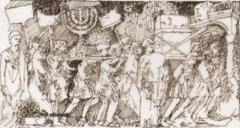This Article: (3 Pages)
- 1. History of Israel
- 2. THE AWAKENING: Jews and Gentile
- 3. DIVIDING the LAND
2) THE AWAKENING: Jews and Gentile
About 1875 anti Jewish pogroms rocked Russia. Russian Jews created the first wave of migration of Jews called “Aliyah” With attacks on Jews increasing in eastern Europe the need for a Jewish homeland was becoming aparent. In Switzerland in 1897 Theodor Herzel’s movement for a homeland quckly spread. Ten years from the day he envisioned Zionism he died of a heart attack aged forty four. He had written in his diary in 1897, “In Basel in Switzerland he established the Zionist movement and the concept of a Jewish Jewish State", but he died before he could see the state, and was eventually buried on Mount Herzl facing toward Jerusalem.
In 1905 Russian and Polish pogroms reached an all time high and a second wave, Aliyah, of Jews went to Palestine. They were full of idealism and swiftly moved into the swamplands as soon as it as it could be purchased.
From 1880 Jewish refugees, including many orphans, out of persecution went to Israel joining those of the nineteenth century, from Russia and Europe. In 1948 “Arabs” were mainly recent immigrants from Syria (eg Abbas’ family), Lebanon, Iraq and Egypt (eg Arafat’s family), Arabs, Of those who had not fled in 1948, almost 40% were Christians. The population also included other Christians and Muslims, placed there by Turkey from Eastern Europe. The indigenous were Jews, Druzes and Bedouins. There were NO Palestinians.

Prior to the Roman period the Jewish homeland had been subject to invasions by Assyria , Babylon, Persia, Greece, Egypt and Rome. The Jews had survived for many centuries but many had been forced to flee into other nations, but a remnant always survived in their homeland. An example is Cyrus the benevolent king of Persia who recognised the Jews’ right to return to their homeland after seventy years in captivity in Babylon, to restore their temple and worship of their God, They returned to Israel and restored the Temple and towns. This is all recorded in detail giving the names and genealogies of those who returned.
In the New Testament we can read the records of genealogies from the time of Adam to to the birth of Israel’s Messiah. This is again evidence of the Jews’ long time association with the land that the Romans renamed as Palestine in AD 135.
By1917 Lord Balfour saw a need for a Jewish homeland for displaced Jews because of the long period of persecution of Jews in Europe and during the war.
The Balfour Declaration made certain provisions regarding the “ Palestinian Jewish State “:
“that nothing shall be done which may prejudice the civil and religious rights of existing non Jewish communities in Palestine”.
The Jews of Israel are now facing an invasion in an attempt to destroy their nation. They are fighting back to survive the attempt to destroy their people and take possession of their country.
Israel had been seen as a homeland for the Jews. The Balfour Declaration was followed by the Mandate system in a Covenant of the League of Nations after World War 1.
The country was defined as Jewish Palestine. It was not was not considered Arab.
In 1920 Article 22 of the Covenant of the League of Nations. (which was ratified as Article 80 of the UN Charter) defined Palestine as Palestinian Jews and would be reconstituted as the Jewish Commonwealth. Jewish Palestine was not considered Arab.
When Germany was defeated in WW1, so too was the Ottoman Empire as its ally, The southern part of its empire, known as Palestine was “mandated to Britain. In 2,000 years no other country had had a homeland in Palestine. In the 1880’s the Jews had begun migrating into Palestine. They began to revitalise the land and rid it of swamps. Along with the Jews some Arabs also immigrated into the land from neighbouring lands. There was never an attempt to rid the land of the Arabs.

 Show All
Show All

